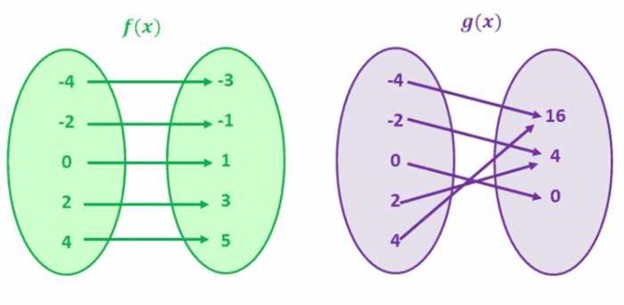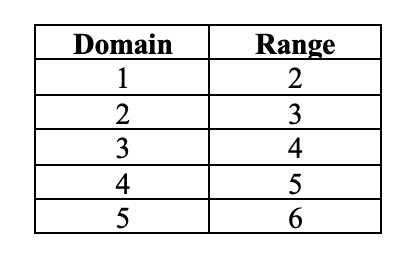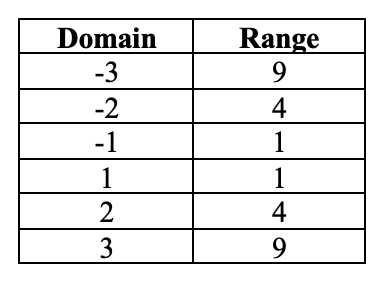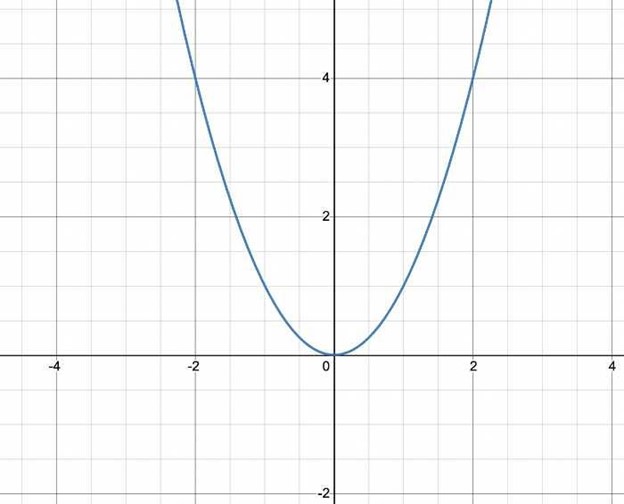One to One Functions - Graph, Examples | Horizontal Line Test
What is a One to One Function?
A one-to-one function is a mathematical function whereby each input correlates to just one output. That is to say, for each x, there is a single y and vice versa. This implies that the graph of a one-to-one function will never intersect.
The input value in a one-to-one function is noted as the domain of the function, and the output value is known as the range of the function.
Let's examine the pictures below:

For f(x), any value in the left circle corresponds to a unique value in the right circle. Similarly, every value on the right side corresponds to a unique value on the left. In mathematical jargon, this signifies every domain has a unique range, and every range has a unique domain. Thus, this is an example of a one-to-one function.
Here are some different representations of one-to-one functions:
-
f(x) = x + 1
-
f(x) = 2x
Now let's study the second example, which displays the values for g(x).
Be aware of the fact that the inputs in the left circle (domain) do not own unique outputs in the right circle (range). For instance, the inputs -2 and 2 have identical output, i.e., 4. In the same manner, the inputs -4 and 4 have identical output, i.e., 16. We can comprehend that there are identical Y values for multiple X values. Hence, this is not a one-to-one function.
Here are some other representations of non one-to-one functions:
-
f(x) = x^2
-
f(x)=(x+2)^2
What are the characteristics of One to One Functions?
One-to-one functions have these characteristics:
-
The function holds an inverse.
-
The graph of the function is a line that does not intersect itself.
-
It passes the horizontal line test.
-
The graph of a function and its inverse are equivalent concerning the line y = x.
How to Graph a One to One Function
When trying to graph a one-to-one function, you are required to figure out the domain and range for the function. Let's look at a straight-forward representation of a function f(x) = x + 1.

As soon as you possess the domain and the range for the function, you need to chart the domain values on the X-axis and range values on the Y-axis.
How can you determine if a Function is One to One?
To indicate if a function is one-to-one, we can leverage the horizontal line test. Once you chart the graph of a function, draw horizontal lines over the graph. If a horizontal line intersects the graph of the function at more than one place, then the function is not one-to-one.
Since the graph of every linear function is a straight line, and a horizontal line will not intersect the graph at more than one point, we can also conclude all linear functions are one-to-one functions. Remember that we do not leverage the vertical line test for one-to-one functions.
Let's study the graph for f(x) = x + 1. Once you chart the values of x-coordinates and y-coordinates, you need to consider if a horizontal line intersects the graph at more than one place. In this case, the graph does not intersect any horizontal line more than once. This signifies that the function is a one-to-one function.

On the contrary, if the function is not a one-to-one function, it will intersect the same horizontal line more than once. Let's examine the graph for the f(y) = y^2. Here are the domain and the range values for the function:

Here is the graph for the function:

In this case, the graph crosses multiple horizontal lines. For example, for both domains -1 and 1, the range is 1. Additionally, for both -2 and 2, the range is 4. This means that f(x) = x^2 is not a one-to-one function.
What is the inverse of a One-to-One Function?
Considering the fact that a one-to-one function has a single input value for each output value, the inverse of a one-to-one function also happens to be a one-to-one function. The opposite of the function basically undoes the function.
For example, in the example of f(x) = x + 1, we add 1 to each value of x as a means of getting the output, or y. The inverse of this function will subtract 1 from each value of y.
The inverse of the function is known as f−1.
What are the characteristics of the inverse of a One to One Function?
The properties of an inverse one-to-one function are identical to any other one-to-one functions. This means that the opposite of a one-to-one function will have one domain for every range and pass the horizontal line test.
How do you figure out the inverse of a One-to-One Function?
Figuring out the inverse of a function is not difficult. You simply have to change the x and y values. Case in point, the inverse of the function f(x) = x + 5 is f-1(x) = x - 5.

Considering what we discussed earlier, the inverse of a one-to-one function undoes the function. Considering the original output value required us to add 5 to each input value, the new output value will require us to delete 5 from each input value.
One to One Function Practice Questions
Examine these functions:
-
f(x) = x + 1
-
f(x) = 2x
-
f(x) = x2
-
f(x) = 3x - 2
-
f(x) = |x|
-
g(x) = 2x + 1
-
h(x) = x/2 - 1
-
j(x) = √x
-
k(x) = (x + 2)/(x - 2)
-
l(x) = 3√x
-
m(x) = 5 - x
For every function:
1. Identify whether the function is one-to-one.
2. Chart the function and its inverse.
3. Find the inverse of the function algebraically.
4. Specify the domain and range of both the function and its inverse.
5. Use the inverse to find the solution for x in each formula.
Grade Potential Can Help You Master You Functions
If you find yourself struggling using one-to-one functions or similar concepts, Grade Potential can set you up with a 1:1 instructor who can assist you. Our Bakersfield math tutors are skilled educators who support students just like you enhance their understanding of these concepts.
With Grade Potential, you can study at your unique pace from the comfort of your own home. Plan a call with Grade Potential today by calling (661) 724-8887 to get informed about our teaching services. One of our representatives will contact you to better determine your needs to find the best tutor for you!




